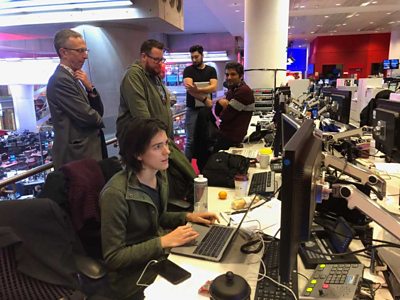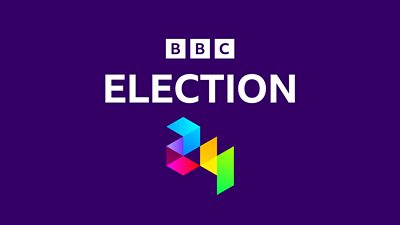The ±«Óãtv's first attempt at televising an election came from two tiny studios at Alexandra Palace in north London.
Broadcast amidst much suspicion from the ±«Óãtv hierarchy and politicians alike, early televised elections built on the experience of delivering results programmes for radio.
Our timeline takes you through every televised ±«Óãtv election programme from the simple studio-bound programme of 1950 to the all-digital world of 2024.
1950s
23 February 1950 - Labour win
Much emphasis is placed on creating an understandable graphic representation of incoming election results in this first ever live election night television special. This is coupled with an election night line-up of experts that become familiar faces for years to come.
This basic formula now lies at the heart of each election night programme, coupled with a speedy results service and accuracy in interpretation.
No recordings exist of the first television election night. This simple newsreel is the only archive material to survive.
25 October 1951 - Conservative win
Just over a year later, the same studio set as used in 1950 returns.
The election results are still painted up on a results board by operatives wearing white coats, but the coverage has sped up and appears more lively.
The night is a more polished affair than before. Outside broadcasts have increased in number and are technically much more successful.
Correspondents meet more real voters in un-scripted and spontaneous situations.
Only newsreel material survives.
26 May 1955 - Conservative win
A hand operated Swing Indicator, which soon becomes known as the "Swingometer", is seen on-screen for the first time nationally - an election night legend is born.
±«Óãtv management becomes much more at ease with election night television programmes by this time.
The style of presentation remains formal, but more human personality starts to comes across and the all-night programme begins to feel more spontaneous.
8 October 1959 - Conservative win
A much less desk-bound election night for 1959 and a more relaxed tone from presenters is evident.
The popular , who is normally to be found in the studio where informal presentation has been pioneered, is the main anchor for the programme.
This is the first time a woman election night correspondent is seen on-screen. Polly Elwes makes her debut.
1960s
15 October 1964 - Labour win
Swinging sixties meets election night.
The studio is arranged as a busy work space, with technology and ±«Óãtv backstage staff clearly seen in-vision.
There’s a party air too, with wine glasses and ash trays visible throughout the broadcast.
A groovy end to proceedings completes the 60s vibe of the programme as A Hard Day's Night by The Beatles is played across shots of exhausted looking staff, piles of scripts and notes and remnants of snacks eaten on the hoof.
31 March 1966 - Labour win
The computer age has come, albeit in a form which takes up a large amount of space in the television studio!
The computer is used throughout the night to predict results and is surprisingly accurate, threatening to put psephologist David Butler out of business.
This is the first major publicly radiated colour television programme broadcast by the ±«Óãtv. However, it is only seen in colour via the Early Bird satellite in the United States, where colour transmissions have already begun.
1970s
18 June 1970 - Conservative win
The first television election night broadcast in colour, seen in the U.K.
Britain is the first country in Europe to broadcast in 1967, and the ±«Óãtv is swift in getting mainstream programmes made using the new technology, which is at times unpredictable.
By 1970 broadcasting in colour is well established, and it lends a whole new dimension to an election night broadcast.
More interaction with viewers is actively sought in this election programme. Calls come in from women voters and a deaf MP is interviewed.
28 February 1974 - Labour minority
10 October 1974 - Labour win
Alistair Burnett, who goes on to front ITN’s News At Ten, is the main presenter for both 1974 election night programmes.
Britain is facing deep economic difficulties. The impact of the oil crisis and frequent strikes, means voters are divided about the way forward.
In both election programmes, Burnett adopts a rather sombre tone. The set and graphics remain the same for each programme, as budgets are tight.
At election counts up and down the country a greater variety of ±«Óãtv personalities set the scene, including and Valerie Singleton.
3 May 1979 - Conservative win
David Dimbleby, involved in every election night since 1964 alongside his father, takes centre stage for the 1979 election broadcast.
He proves to be highly skilled at chairing an increased number of studio discussions and linking to more outside broadcasts than ever before, whilst keeping the irascible under control.
The title music is 'Arthur' by Rick Wakeman from his 1975 concept album The Myths and Legends of King Arthur and the Knights of the Round Table. The theme goes on to be used for subsequent elections until 1997, before making a final appearance in 2005.
Angela Ripon becomes the first woman to have a regular role as a studio presenter in an election night programme.
1980s
9 June 1983 - Conservative win
Peter Snow – for so long associated with the Swingometer makes his election night debut.
He uses improved computer graphics throughout the night, largely designed in-house by the ±«Óãtv.
The vast scale and impressive colours of later Swingometer is still some years off.
11 June 1987 - Conservative win
A business-like approach is very much in evidence on set in the 1987 programme.
Blue dominates and tradition abounds.
David Dimbleby is the main host for the entire evening with his familiar band of experts.
Computer graphics play a much greater part in this programme, along with impressive opening titles.
1990s
9 April 1992 - Conservative win
The largest studio at (TC-1) is used for the election night programme of 1992.
This is, arguably, the first that resembles the most recent election broadcasts.
The internet features, but real interaction with the audience is limited as social media has barely made its mark on the world.
1 May 1997 - Labour win
Peter Snow is in his element as the challenge to impress the audience with the best possible election night programme is intensified.
He takes to the new Swingometer easily, and is much admired for his super-quick predictions.
2000s
7 June 2001 - Labour win
There are more ±«Óãtv reporters out on the road than ever before.
At last the audience can have faster and more direct input into the election night programme because of improved internet, and the rise of social media.
The expertise in the studio remains as solid and reliable as ever.
5 May 2005 - Labour win
An even higher level of computer graphic sophistication for Peter Snow.
He presides over not only his beloved Swingometer, but numerous other graphic devices such as 'the rotating triangle'.
British politics enters a ‘three party battle ground’, and the political makeup of the country becomes less clear cut.
Comedy also starts to make inroads, with a quick visit from ‘George W. Bush’ aka Rory Bremner.
2010s
6 May 2010 - Hung parliament: Conservative Lib Dem Coalition
By 2010, the political battlefield is more complex than ever, and the results at the end of election night are inconclusive.
Interpreting this multifaceted situation is not easy, and the demands from the audience are high - they want to take part in the election news as it happens, and the use of social media on air increases massively.
7 May 2015 - Conservative win
David Dimbleby presents the 2015 Election coverage aided by a vast array of interpretative computer graphics.
The main election night studio moves to the ±«Óãtv's Elstree Centre following the closure of Television Centre.
The new piazza at Broadcasting House is also featured, with an outside broadcast of a giant physical map made of tiles for each constituency, with graphics projected onto Old Broadcasting House.
8 June 2017 - Conservative minority
In April 2017, Prime Minster Theresa May calls a snap election, not long after the advisory United Kingdom European Union membership referendum on June 23 2016.
By the time of Election 2017 on June 8, presenter David Dimbleby has hosted nine election nights. His 10th and final overnight broadcast runs for nine hours, and he steers the coverage through hundreds of declarations, hours of pollster speculation, and the occasional technical fault with deftness.
The election night programme is simulcast live from ±«Óãtv Elstree Studio D, on ±«Óãtv One, ±«Óãtv News Channel, ±«Óãtv World News, and streamed online.
The Conservatives remain the largest party in the House of Commons on 318 seats, not quite the 326 needed to win an outright majority resulting in a hung parliament.
12 December 2019 - Conservative win
Using the new Semi-Automated Local Content (SALCO) system, ±«Óãtv News online publishes all returning results with analysis within hours across 650 electoral areas in the UK.
The aim is to publish a local story for every licence fee payer on election night - the ambitious project succeeds.
A cross ±«Óãtv collaboration using newsrooms in Scotland, Wales, Northern Ireland and London, builds a natural language generation template that creates a story for every constituency with the latest updates.

2020s
4 July 2024
±«Óãtv Election 24 - a truly digital election relevant for the 21st century with coverage across all online platforms as well as traditional television and radio.
±«Óãtv News also takes on the role of convenor, in an attempt to bring people together.
Where algorithms serve people's own point of view more and more, the election on the ±«Óãtv provides a shared space where voters can listen to each other and agree to disagree.
±«Óãtv News sets out a pledge for election night 2024 - to provide a place where everyone has a voice - on whatever platform they use.

Search by Tag:
- General Election 1950
- Voices of the ±«Óãtv
- Elections
- General Election 1951
- General Election 1955
- General Election 1959
- General Election 1964
- General Election 1966
- General Election 1970
- General Election 1974
- General Election 1979
- General Election 1983
- General Election 1987
- General Election 1992
- General Election 1997
- General Election 2001
- General Election 2005
- General Election 2010
- General Election 2015
- General Election 2017
- General Election 2019
- General Election 2024
